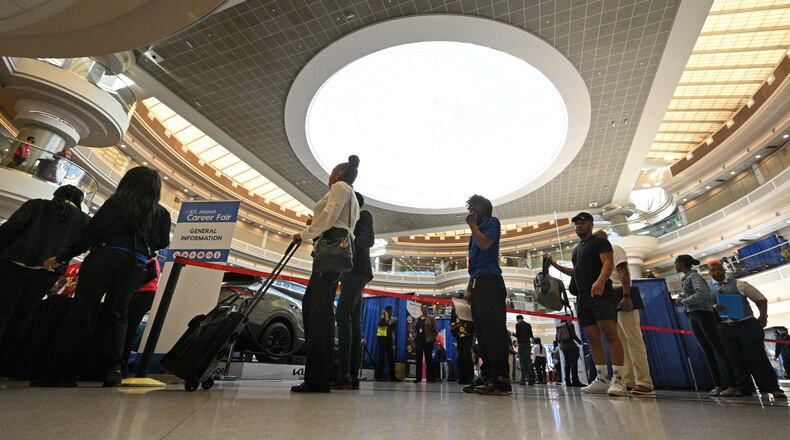Despite a range of economic warnings and worries, metro Atlanta added 8,300 jobs last month, fueled by hiring in hospitality, health care and a variety of white-collar work, the state Department of Labor announced Thursday.
That growth was just shy of the average for a pre-pandemic April.
After steadily climbing out of the deep hole created by massive losses early in the pandemic, the region now has 160,800 more jobs than before the virus struck, and there is still much room for growth, said Bruce Thompson, state labor commissioner. “As we approach the summer months, we are optimistic that job growth will remain steady in virtually every sector in the state.”
The sectors with the most job gains in April were accommodation and food services, which added 3,700 jobs, and health care and social assistance, which added 3,000.
At least so far, that growth is continuing.
About 129,000 positions were listed Thursday for the metro Atlanta area, according to online jobs site Indeed, including more than 11,000 at restaurants, 27,000 in health care and nearly 2,000 positions in social assistance.
Seniors Helping Seniors, for instance, plans to hire up to 15 caregivers as it opens an office in Lilburn to serve the area. Caregivers will typically visit clients in their homes and will be paid $15 or $16 an hour to start, a spokeswoman for the company said.
Yet concerns remain.
Inflation has ebbed, but is still higher than it has been for most of the past four decades. Interest rates have been rising, the result of the Federal Reserve’s efforts to tame that inflation by cooling growth. And those higher rates make borrowing more costly, which tends to make consumers more cautious in spending and companies more conservative about expansion.
Last year, many economists predicted recession. That hasn’t happened, but there are signs that the pace of growth has flagged. Hiring in April was a bit weaker than the pre-pandemic average for the month, while the number of people filing for unemployment insurance rose 8 percent from March, according to the Department of Labor.
Perhaps the most negative piece of data came shrouded in what seems like good news.
The unemployment rate fell from 3.2% in March to a historically low 2.7%, but the decline came largely because the number of people in the labor force — people either working or actively searching for a job — fell by 26,580.
That is a steeper decline than in any previous, pre-pandemic April.
Historically, people leave the labor market when they think jobs are scarce, so a decline has been a sign that hiring has cooled and workers are discouraged. But this drop may just show how much more flexible people have become, said Michael Wald, a former U.S. Labor Department economist.
“Older workers can retire and un-retire,” he said. “Younger workers may move into and out of the formal job market into a more informal job market that is hard to measure through ‘gig’ jobs and self-employment.”
Moreover, the changed attitude may be especially true for low-income service jobs that workers can quit without hurting their long-term goals, he said. “The job is becoming only a job.”
Whatever the reason, a scarcity of labor makes it harder for growing companies that were already complaining of trouble finding — and keeping — skilled workers.
Winton Machine has recently hired four people, but that isn’t enough, said Lisa Winton, chief executive of the 40-person Suwanee company, which makes machines used by other companies to craft tubes and cables.
“Do you know any machinists?” she said. “We have two job openings.”
Solvay, which has about 500 employees in a new research center in Alpharetta, expects to add about 50 more, mostly scientist and technicians, according to Herve Tiberghien, the company’s chief people officer.
Tightness in the labor market makes hiring more of a challenge than usual, he said. “We’ve had ghost candidates, candidates that you interview, you sign and then they don’t show up.”
But the economic environment can change quickly. If the impasse between Congress and the White House does not produce a bill that raises the debt ceiling — and if the president doesn’t find some other way to get it done — the federal government will default on its bills.
If that happens, it would likely significantly raise interest rates, force many workers out of jobs and push the country into a recession.
Solvay has managed thus far to outmaneuver economic pitfalls and, while aware of the dangers, expects to succeed, Tiberghien said. “We are confident in the future. We control what we can control.”
Metro Atlanta jobs in April
Best pre-pandemic: 30,500 (2005)
Worst pre-pandemic: -6,600 (2009)
Average pre-pandemic: 10,000
Recent: 8,300 (2023)
Metro Atlanta unemployment rate
Best pre-pandemic: 2.6% (Dec. 2000, Dec. 1999)
Worst pre-pandemic: 11.1% (June 2009)
Average pre-pandemic: 5.5% (1990-2019)
Last month, pre-pandemic: 3.4% (Feb. 2020)
Recent: 2.7% (April 2023)
Sources: Bureau of Labor Statistics, Georgia Department of Labor, staff research
About the Author
Keep Reading
The Latest
Featured



